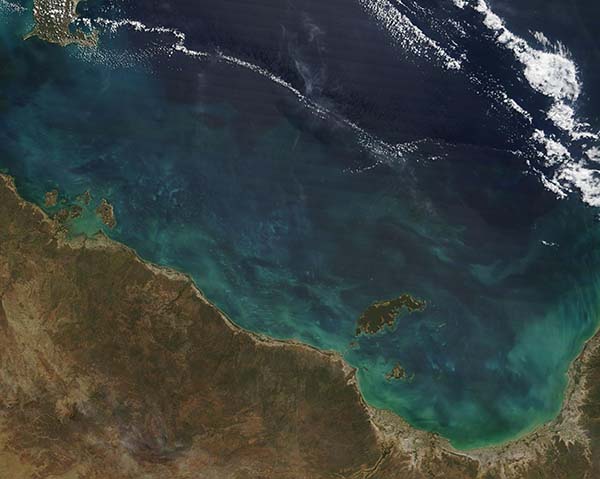Images
April 10, 2022 - Gulf of Carpenteria
Tweet
Aqua and turquoise colored the blue waters in the Gulf of Carpentaria on April 8, 2022, when the Moderate Resolution Imaging Spectroradiometer (MODIS) on board NASA’s Terra satellite acquired this true-color image. The widespread color are a combination of sediment and phytoplankton.
South of the Arafura Sea, the Gulf of Carpentaria is a large, shallow sea snuggled between the eastern coast of Northern Territory and the northwestern coast of Queensland, Australia. Fifteen rivers pour fresh water into the saline Gulf waters—and along with the river water comes copious sediment, especially at the end of the rainy season. When sediment sits near the surface, it appears tan, but as it sinks under the water the reflective properties of sediment change, and so does the color, as viewed from space, changing to green and then blue. Sediment and river run-off also carries nutrients into the Gulf, which can spur a bloom of phytoplankton. Phytoplankton are microscopic plant-like, chlorophyll-containing organisms that exist in these waters year-round in small numbers. When favorable water temperature, appropriate daylight length, and abundant nutrients combine, phytoplankton can reproduce explosively, creating massive blooms that can be easily seen from space. It is likely that the color near shore is predominantly from sediment while most of the color further away from shore is more likely from phytoplankton.
Image Facts
Satellite:
Terra
Date Acquired: 4/8/2022
Resolutions:
1km (54.5 KB), 500m (137.1 KB), 250m (377.3 KB)
Bands Used: 1,4,3
Image Credit:
MODIS Land Rapid Response Team, NASA GSFC
Tweet
Aqua and turquoise colored the blue waters in the Gulf of Carpentaria on April 8, 2022, when the Moderate Resolution Imaging Spectroradiometer (MODIS) on board NASA’s Terra satellite acquired this true-color image. The widespread color are a combination of sediment and phytoplankton.
South of the Arafura Sea, the Gulf of Carpentaria is a large, shallow sea snuggled between the eastern coast of Northern Territory and the northwestern coast of Queensland, Australia. Fifteen rivers pour fresh water into the saline Gulf waters—and along with the river water comes copious sediment, especially at the end of the rainy season. When sediment sits near the surface, it appears tan, but as it sinks under the water the reflective properties of sediment change, and so does the color, as viewed from space, changing to green and then blue. Sediment and river run-off also carries nutrients into the Gulf, which can spur a bloom of phytoplankton. Phytoplankton are microscopic plant-like, chlorophyll-containing organisms that exist in these waters year-round in small numbers. When favorable water temperature, appropriate daylight length, and abundant nutrients combine, phytoplankton can reproduce explosively, creating massive blooms that can be easily seen from space. It is likely that the color near shore is predominantly from sediment while most of the color further away from shore is more likely from phytoplankton.
Image Facts
Satellite:
Terra
Date Acquired: 4/8/2022
Resolutions:
1km (54.5 KB), 500m (137.1 KB), 250m (377.3 KB)
Bands Used: 1,4,3
Image Credit:
MODIS Land Rapid Response Team, NASA GSFC




